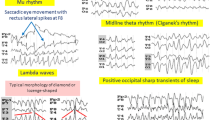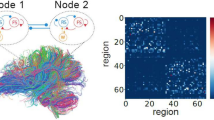Abstract
Electroencephalographic (EEG) activity was recorded from hippocampus and neocortex of rabbits. It was found that movement, movement-related 6–12 Hz rhythmical slow actvity (RSA), and movement-related neocortical desynchronization were unaffected by intravenous atropine sulfate but depressed by ethyl alcohol (ethanol). Slower 4–8 Hz immobility-related RSA and immobility-related neocortical desynchronization produced by sensory stimulation (visual, auditory, tactle, vestibular) were relatively unaffected by ethanol even at high (0.1–0.2 g-%) blood alcohol levels, but were abolished by atropine sulfate. The results provide evidence for the idea of two pharmacologically separable cortical activating systems and suggest that ethanol has a greater effect on noncholinergic than cholinergic systems.
Similar content being viewed by others
References
Bland, B. H., Andersen, P., Ganes, T.: Two generators of hippocampal activity in rabbits. Brain Res. 94, 199–218 (1975)
Bland, B. H., Vanderwolf, C. H.: Diencephalic and hippocampal mechanisms of motor activity in the rat: Effects of posterior hypothalamic stimulation on behavior and hippocampal slow wave activity. Brain Res. 43, 67–88 (1972a)
Bland, B. H., Vanderwolf, C. H.: Electrical stimulation of the hippocampal formation: Behavioral and bioelectrical effects. Brain Res. 43, 89–106 (1972b)
Bland, B. H., Whishaw, I. Q.: Topography and generator mechanisms of theta (RSA) in anaesthetized and freely moving rat. Brain Res (in press, 1976)
Green, J. D., Ardiuni, A. A.: Hippocampal electrical activity in arousal. J. Neurophysiol. 17, 533–557 (1954)
Harper, R. M.: Frequency changes in hippocampal electrical activity during movement and tonic immobility. Physiol. and Behav. 7, 55–58 (1971)
Himwich, H. E., Callison, D. A.: The effects of alcohol on evoked potentials of various parts of the central nervous system of the cat. In: The biology of alcoholism, B. Kissin and H. Begleiter, eds. Vol. 2, pp. 67–84 New York: Plenum Press 1972
Himwich, H. E., DiPerri, R., Dravid, A., Schweigerdt, A.: Comparative susceptibility to alcohol of the cortical area and midbrain reticular formation of the cat. Psychosom. Med. 28, 458–463 (1966)
Horsey, W. J., Akert, K.: The influence of ethyl alcohol on the spontaneous electrical activity of the cerebral cortex and subcortical structures of the cat. Psychosom. Med. 28, 458–463 (1966)
Kalant, H.: Effects of ethanol on the nervous system. In: International encyclopedia of pharmacology and therapeutics, Section 20, Alcohols and derivatives, J. Tremoliers, ed., pp. 189–236, Oxford: Pergamon Press 1970
Kramis, R., Vanderwolf, C. H., Bland, B. H.: Two types of hippocampal rhythmical slow activity (RSA) in both the rabbit and the rat: Relations to behavior and effects of atropine, diethyl ether, urethane, and pentobarbital. Exp. Neurol. 49, 58–85 (1975)
LeBlanc, A. E., Kalant, H., Gibbins, R. J.: Acute tolerance to ethanol in the rat. Psychopharmacologia (Berl.) 41, 43–46 (1975)
Lewis, P. R., Shute, C. C. D.: The cholinergic limbic system: Projection to hippocampal formation, medial cortex, nuclei of the ascending cholinergic reticular system, and the subfornical organ and supra-optic crest. Brain 90, 521–540 (1967)
Mardones, J.: The alcohols. In: Physiology and pharmacology, S. W. Root and F. G. Hofmann, eds., Vol. 1, pp. 99–183. New York: Academic Press 1963
Martin, J. T., Faulconer, A., Jr., Bickford, R. G.: Electroencephalography in anaesthesiology. Anaesthesiology 20, 359–376 (1959)
Ohga, N.: Electroencephalographical studies on alcohol intoxication in rabbits. Jap. J. Legal Med. 16, 196–213 (1962) (translation supplied by H. Kalant)
Perrin, R. G., Hockman, C. H., Kalant, H., Livingston, K. E.: Acute effects of ethanol on spontaneous and auditory evoked electrical activity in cat brain. Electroenceph. clin. Neurophysiol. 36, 19–31 (1974)
Ritchie, J. M.: The aliphatic alcohols. In: The pharmacological basis of therapeutics, L. S. Goodman and A. Gillman, eds., pp. 135–150. Toronto: Collier-MacMillan 1970
Robinson, T. E., Whishaw, I. Q.: Effects of posterior hypothalamic lesions on voluntary behavior and hippocampal electroencephalograms in the rat. J. comp. physiol. Psychol. 86, 768–786 (1974)
Sainsbury, R. S.: Hippocampal activity during natural behavior in the guinea pig. Physiol. and Behav. 5, 317–324 (1970)
Shute, C. C. D., Lewis, P. R.: The ascending cholinergic reticular system: Neocortical, olfactory and subcortical projections. Brain 90, 497–520 (1967)
Storey, J. L., Eidelberg, E., French, J. D.: Electrographic changes induced in cats by ethanol intoxication. Arch. Neurol. (Chic.) 5, 119–124 (1961)
Vanderwolf, C. H.: Hippocampal electrical activity and voluntary movement in the rat. Electroenceph. clin. Neurophysiol. 26, 407–418 (1969)
Vanderwolf, C. H.: Neocortical and hippocampal activation in relation to behavior: Effects of atropine, eserine, phenothiazines and amphetamine. J. comp. physiol. Psychol. 88, 300–332 (1975)
Vanderwolf, C. H., Kramis, R., Gillespie, L. A., Bland, B. H.: Hippocampal rhythmical slow activity and neocortical low voltage fast activity: Relations to behavior. In: The hippocampus: A comprehensive treatise, R. L. Isaacson and K. H. Pribram, eds. New York: Plenum 1975
Whishaw, I. Q.: Hippocampal electroencephalographic activity in the Mongolian gerbil during natural behaviors and wheel running and in the rat during wheel running and conditioned immobility. Canad. J. Psychol. 26, 219–239 (1972)
Whishaw, I. Q., Bland, B. H.: Origin and pharmacology of two types of RSA (theta) in two hippocampal generators. Proceedings of the Canad. Fed. Biol. Soc. (in press, 1976)
Whishaw, I. Q., Bland, B. H., Vanderwolf, C. H.: Hippocampal activity, behavior, self-stimulation, and heart rate during electrical stimulation of the lateral hypothalamus. J. comp. physiol. Psychol. 79, 115–127 (1972)
Whishaw, I. Q., Vanderwolf, C. H.: Hippocampal EEG and behavior: Effects of variation in body temperature and relation of EEG to vibrissae movement, swimming and shivering. Physiol. and Behav 6, 391–397 (1971)
Whishaw, I. Q., Vanderwolf, C. H.: Hippocampal EEG and behavior: Changes in amplitude and frequency of RSA (theta rhythm) associated with spontaneous and learned movement patterns in rats and cats. Behav. Biol. 8, 461–484 (1973)
Winson, J.: Patterns of hippocampal theta rhythm in the freely moving rat. Electroenceph. clin. Neurophysiol. 36, 291–301 (1974)
Author information
Authors and Affiliations
Rights and permissions
About this article
Cite this article
Whishaw, I.Q. The effects of alcohol and atropine on EEG and behavior in the rabbit. Psychopharmacology 48, 83–90 (1976). https://doi.org/10.1007/BF00423311
Received:
Accepted:
Issue Date:
DOI: https://doi.org/10.1007/BF00423311




